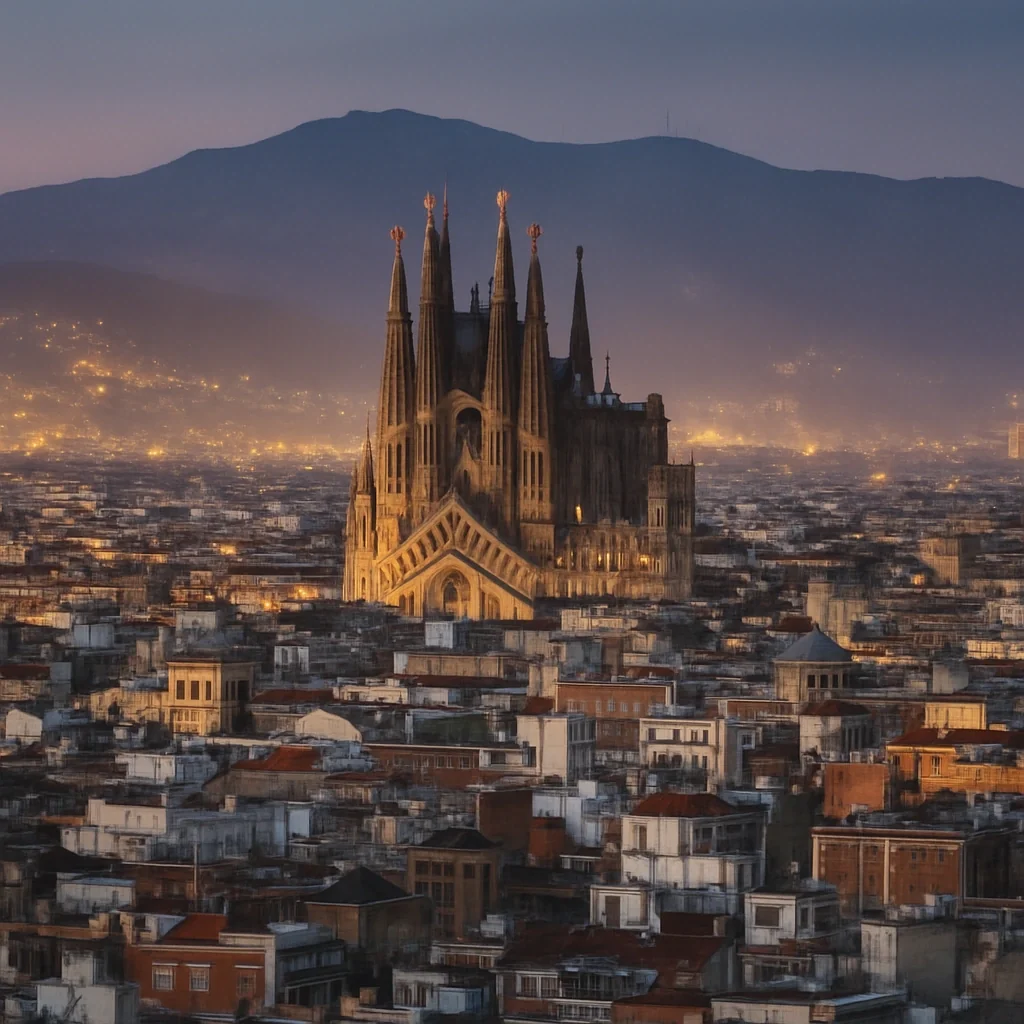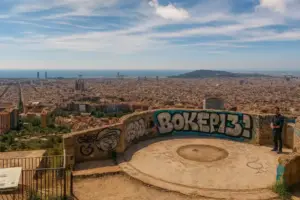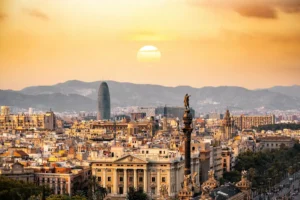What to See in Barcelona in 1 or 3 Days (a Weekend Getaway)?
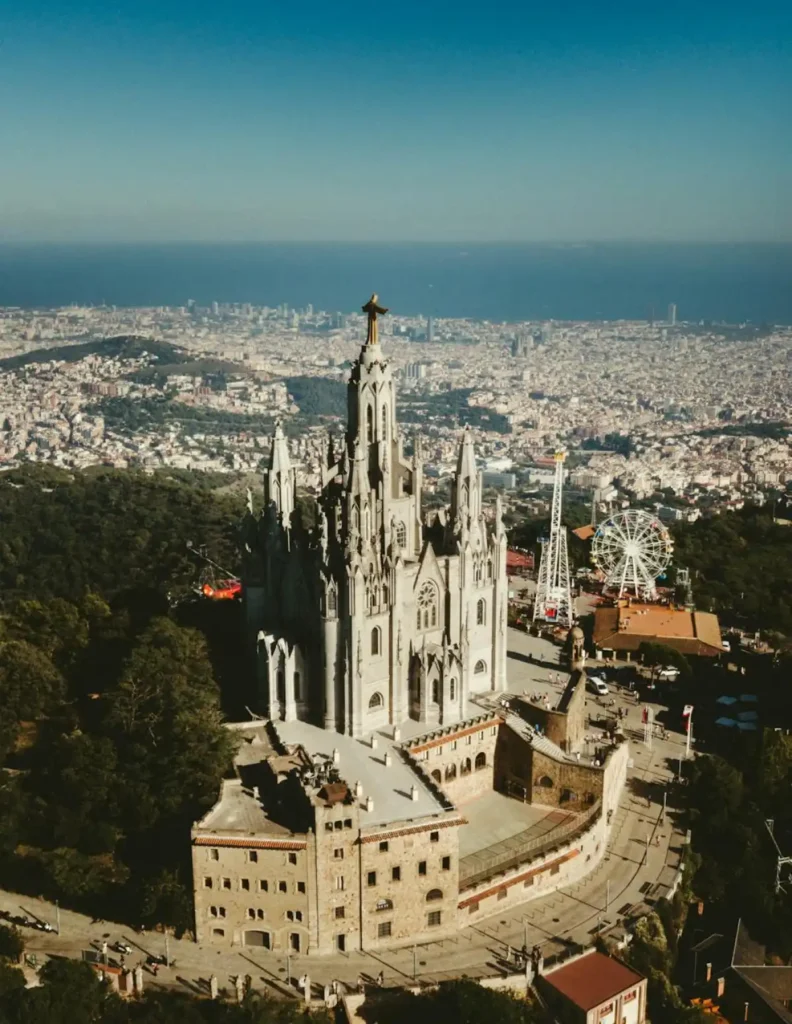
Are you looking for must-see places to visit in Barcelona, Spain? This city, often described as Mediterranean and cosmopolitan, blends within it urban remains, medieval neighborhoods, and architecture from the Modernisme period and the 20th-century avant-garde.
Barcelona is home to several UNESCO World Heritage Sites thanks to its emblematic buildings and its remarkable cultural, historical, and artistic heritage. It’s the perfect city to visit, offering numerous museums, shows, dance, historic buildings, and colorful parks, as well as exquisite cuisine.
Within Catalonia there are other tourist destinations that also attract many travelers, such as Tarragona or Girona. However, these are the must-see places to see and visit in Barcelona in 3 days (or on a weekend getaway). Take note!
Day 1: Discovering Barcelona’s Essentials
Start your visit at La Sagrada Família, one of the masterpieces of the architect Antoni Gaudí and undoubtedly Barcelona’s most iconic symbol. Don’t forget to buy your tickets in advance, as this monument is in high demand. Stroll through the Gothic Quarter, which will transport you back to medieval times with its narrow streets and charming squares like Plaça Reial. End the day walking along Las Ramblas, the famous avenue full of life, street artists, and flower stalls.
Day 2: Art, Modernism, and Nature
Dedicate your second day to enjoying art and Modernism. Visit Park Güell, another of Gaudí’s wonderful designs, filled with colorful mosaics and breathtaking city views. Then head to La Pedrera (Casa Milà) and Casa Batlló, two Modernist gems located on the famous Passeig de Gràcia. Take the opportunity to stroll and discover other magnificent Modernist façades while enjoying the exclusive shops and the unique atmosphere of this avenue.
Day 3: Culture and Panoramic Views
On your last day, make time to visit Montjuïc Hill, where you can explore the Fundació Joan Miró and the National Art Museum of Catalonia (MNAC). Don’t forget to go up to Montjuïc Castle for a spectacular view of the city and the port. Finish your getaway with a stroll through Port Vell and enjoy dinner at one of the nearby restaurants, trying delicious paella or a selection of tapas.
These three days will give you a complete overview of the best Barcelona has to offer. From its unparalleled architecture to its cultural venues, the city offers endless options that will make your weekend escape unforgettable.
Gothic Quarter, Barcelona

One of the best-known neighborhoods is the Gothic Quarter, home to the greatest treasures of Gothic buildings in all of Europe. It’s known for its medieval layout, narrow streets, hidden squares, and a mix of old and modern buildings.
Want to know some curiosities about Barcelona’s Gothic Quarter?
Let Guruwalk’s LOCAL GUIDES tell you!
The Mysterious Cuts in the Stones of Barcelona’s Gothic Quarter — Be Local Tours
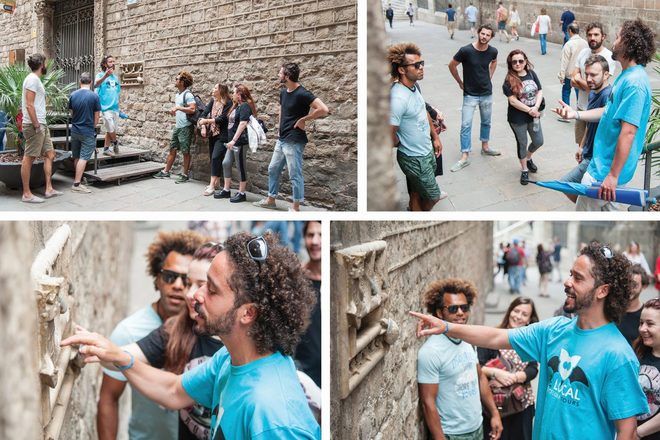
As you walk through the narrow, dark streets of the Gothic Quarter—the oldest part of medieval Barcelona—there’s a curious detail you can notice in the old stones of its walls.
In several spots around the Cathedral and the Royal Major Palace, you’ll see curious vertical cuts, clearly marked and deep, as if a ferocious animal had taken out its fury on the walls of those ancient buildings. What mystery lies behind these wild-looking grooves?
Nothing terrifying—in fact, something surprisingly practical. During the Middle Ages and up until not so long ago, it was customary to sharpen knives and other tools on the stones of public places.
In the past there was no concept of preserving or protecting artistic and cultural heritage. So no one in Barcelona reproached citizens for sharpening their tools on these “public” sharpeners. It was a very practical way to keep knives with a good edge.
Some stones, due to their resistance and quality, were perfect for the task. The karstic sandstone from Montjuïc—one of Barcelona’s Sacred Mountains—is the material used throughout the city’s history to build its most important buildings. From the imposing Roman wall to the majestic Sagrada Família, Barcelona’s trajectory is carved in this noble, ancient stone.

The only ones who probably weren’t too happy seeing these DIY sharpeners were the esmolets, the professional knife-sharpeners who walked Barcelona’s streets carrying their grinding wheel on their shoulders, playing the sonaveus—a syrinx or Pan flute—with which they announced their presence to potential customers. A sound our grandparents and great-grandparents would still remember.
TIP
If you want to discover every corner and secret of Barcelona’s Gothic Quarter, don’t hesitate to book the free tour with the best local guides: Guruwalk.
“El món neix en cada besada” — Cat Tours

The World Begins with Every Kiss is a hidden mural in one corner of Barcelona’s Gothic Quarter. It appears as a mosaic made of 4,000 photos sent at random by readers of El Periódico de Catalunya and set in ceramic to commemorate the feeling of “living free” in 2014—an idea carried out by photographer Joan Fontcuberta and inspired by the poem of Oliver Wendell Holmes.
The sound of a kiss is not so loud as that of a cannon, but its echo lasts a great deal longer. — Oliver Wendell Holmes
Sagrada Família

The Sagrada Familia is the city’s quintessential symbol—the most famous and distinctive in all of Barcelona. This Modernist work by Spanish architect Antoni Gaudí i Cornet is a still-unfinished basilica visited by thousands of tourists every day. You can also book a guided tour to get to know this magnificent place in detail.
History of the Monument
The first stone was laid in March 1882 in a Neo-Gothic style. The crypt was then built and, after disagreements with the promoters, the basilica came into Gaudí’s hands, who completely re-planned it. When the architect died (1926), the basilica was not finished, but thanks to the plans preserved since then, construction could continue.
Most Notable Elements of the Sagrada Família
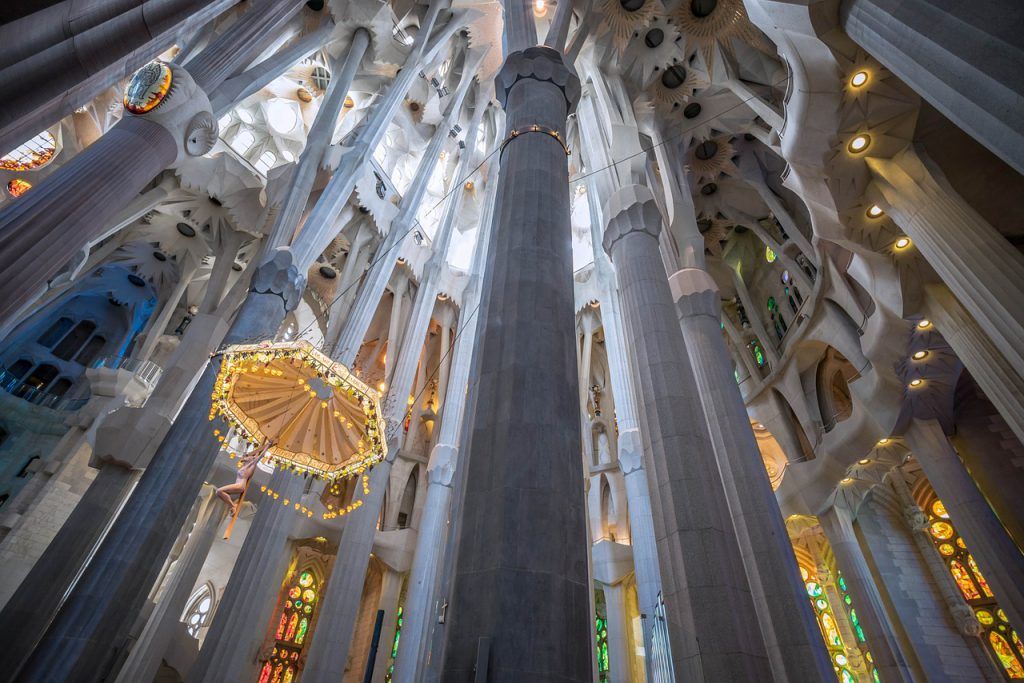
The towers — So far, 8 of the 18 towers that make up the Sagrada Família have been raised. Interestingly, Gaudí decided to dedicate them to the Apostles, the Evangelists, the Virgin Mary, and the child Jesus. The façades — The main façade, or Glory Façade, represents death, Judgment Day, glory, and the abyss. The second façade depicts the birth of Jesus Christ and is therefore full of life. The third and last highlighted façade is the Passion Façade, rather sober as it reflects Jesus’s suffering at the time of his crucifixion. The interior — The interior of the Sagrada Família is spectacular, with enormous columns shaped like tree trunks made of red porphyry volcanic rock and granite, and light from the street filtering in. The altar and the crypt deserve a mention; in the latter, you’ll find two angels and an image of Jesus on the famous cross.
Tip for Your Visit
Beyond what we can tell you from a historical point of view, there are always details you only appreciate when you’re there. That’s why we recommend visiting the Sagrada Família with a local guide who can tell you all the curiosities of the place and answer any questions you may have.
Els Quatre Gats

If you’ve made it this far, you can already see that Barcelona is a city strongly influenced by Modernism. This place is one of the city’s secret corners, so pay attention to what the local guides from Cat Tours tell us.
History of ‘Els Quatre Gats’
Barcelona is a global reference in architecture thanks in part to the Modernist movement that emerged strongly in the late 19th and early 20th centuries. Great names such as Antoni Gaudí with his incredible monuments like the Sagrada Família or Casa Batlló, and Lluís Domènech i Montaner with his beautiful Palau de la Música Catalana and Hospital de Sant Pau, reflect the power of that era. However, not everything in Barcelona is “Gaudí”, and that’s why highlighting the work of Josep Puig i Cadafalch is important—what better way to do so than by considering the masterpiece that is the Els Quatre Gats building and its incredible history.
Els Quatre Gats is an artistic symbol of the city. Figures such as Salvador Dalí, Pablo Picasso, Mario Casas, among others, have had more than one encounter with the various tapas and drinks offered by this famous beer hall, which first opened in 1896. Its direct inspiration was the Parisian cabaret Le Chat Noir (“The Black Cat”), whose name jokingly invokes the saying that “only four cats come here” (meaning “hardly anyone”).

Part of its reputation rests on the fact that none other than Pablo Picasso held his first solo exhibition under this venue’s roof in February 1905. In gratitude, today we can see the poster that Picasso made for them right at the building’s entrance.
If you pass through Barcelona, you can’t miss this corner of the city. It showcases the imposing Modernism of the era mixed with the eccentricities of various artists of the time—and even of our days.
Las Ramblas, One of the Must-See Places in Barcelona

Did you know Las Ramblas is the most emblematic street in all of Barcelona? It’s the most central promenade that crosses the city center. It’s known for being a pleasant 1.3-kilometer walk that links Plaça de Catalunya with the old port.
Wax Museum

The Wax Museum is a grand Neoclassical building that houses more than 200 wax figures of famous and historical characters. The most curious room is the bank’s armored vault.
La Boqueria Market

La Boqueria is the most famous market worldwide, with more than 2,500 square meters and over 300 stalls offering all kinds of food—sweets, fruit cups, eggs, meat, fish, and more.
| PRICE | Free entry. |
| HOURS | Monday to Saturday: 08:00–20:30. |
Tips for Visiting La Boqueria Market
⏰ Best time: Between 8:00 and 10:00 a.m. you’ll find the most activity and the most authentic atmosphere.
❌ Avoid Saturdays: The market is usually too crowded and full of tourists.
💶 Payment method: It’s advisable to carry cash since some traditional stalls do not accept cards.
Monument to Christopher Columbus

The monument to Christopher Columbus was built in 1888 to commemorate the navigator’s landing in Barcelona after discovering the New World. It stands out for its 60-meter height and its location at the end of Las Ramblas, next to the port.
Passeig de Gràcia

Another must-visit place in Barcelona is Passeig de Gràcia, described as an elegant, stately boulevard of Barcelona’s 19th-century bourgeoisie. It connects Plaça de Catalunya with the Gràcia neighborhood, and those who stroll along it can admire numerous oversized Modernist and Noucentista buildings. Two of the most outstanding jewels are the buildings created by Antoni Gaudí, explained below.
Casa Batlló
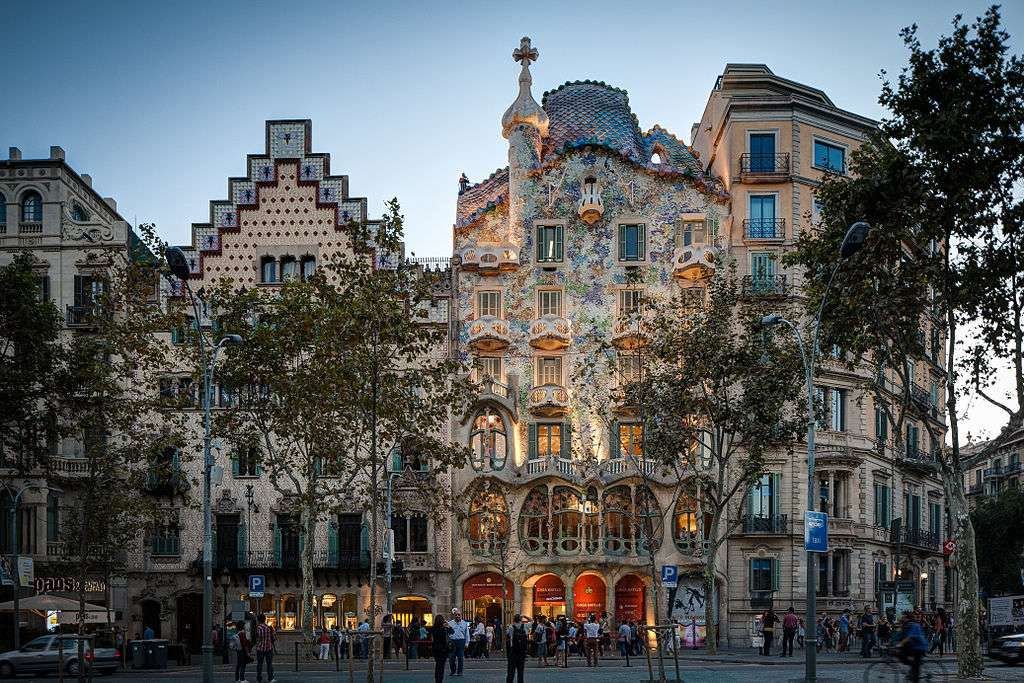
Casa Batlló was designed by Gaudí for Josep Batlló and built between 1904 and 1906. The façade is highly original: the balconies look like skulls and the pillars like bones, playing with optical illusion. The interior is fantastic, and with the audio guide you tour the former residence of the family who lived there to discover all the most interesting hideaways, plus a light-filled courtyard and a rooftop with very original chimneys.
La Pedrera (Casa Milà)

La Pedrera, or Casa Milà, was built between 1906 and 1912 by the Spanish architect at the request of Pere Milà and Roser Segimon as a residence. This civic building stands out for its innovative construction and its aesthetic and decorative solutions: the façade is undulating limestone with huge windows and interlaced balconies. On the visit, the most curious part is the rooftop, where you’ll find elements such as stairwell boxes, skylights, chimneys, and ventilation towers open to interpretation.
Tip for Your Visit
Without a doubt, one of the must-see places in Barcelona when you visit. We recommend this tour with a local guide so you can discover all the secrets of Catalan culture.
Hospital de la Santa Creu i Sant Pau

Thanks to a substantial donation, construction of the Hospital de la Santa Creu i Sant Pau began in the early 20th century under the Modernist architect Lluís Domènech i Montaner. The hospital covers nine city blocks in a square plot of 300 meters per side and has 27 pavilions. Today, it is a UNESCO World Heritage Site.
The architect gave it a thoroughly avant-garde style and, for 80 years, it was the place where the poor were cared for. The hospital can be visited on your own, with an audio guide, or on a guided tour to learn all the details of this site—witness to a bygone era.
El Born

What better than to make the most of one of Barcelona’s best-known neighborhoods: El Born. The area is full of must-see places in Barcelona that we highly recommend.
Brief History
El Born was the economic hub between the 13th and 15th centuries as one of the trade routes, which increased wealth and led to very distinguished buildings such as the palaces on Carrer Montcada. Little by little it lost relevance with the destruction of the famous Ciutadella, a military fortress located in what is now the Parc de la Ciutadella.
What to Do in El Born, Barcelona?
One of the neighborhood’s notable landmarks is the basilica of Santa Maria del Mar, built between 1329 and 1383 in the Gothic style. Also worth mentioning is the Picasso Museum—a cultural symbol of El Born and one of the most visited daily—Santa Caterina Market, a walk along Via Laietana, and Carrer Princesa.
Tips for Your Visit to El Born
El Born is one of Barcelona’s most picturesque neighborhoods. We recommend visiting early in the morning to avoid tourist crowds and enjoy its authentic local essence. Don’t miss the small cafés and traditional patisseries you’ll find in its narrow streets.
Park Güell, Barcelona

Park Güell is a public park with gardens and architectural features located in the northern part of Barcelona. The design was led by architect Antoni Gaudí, and construction took place between 1900 and 1914 in a natural setting with the best views. These are the park’s most famous spots.
Nature Square
An esplanade remarkable for its natural beauty, bordered by a huge undulating bench covered with beautiful mosaic; a spot from which to take in city views.
The Dragon Stairway
An impressive staircase structured in three sections and made of stone; at the top is the well-known salamander, or dragon, covered in mosaic, which has become the park’s icon.
The Hypostyle Hall
This hall is supported by 86 columns that collect rainwater and are intended to hold up Nature Square. The ceiling domes are adorned with ceramic mosaics.
Montjuïc

Besides Tibidabo, Montjuïc is the other hill in Barcelona. It’s one of the city’s areas packed with attractions and, in the past, played a fundamental role in defending the city.
What to See on Montjuïc, Barcelona?
It’s ideal for visiting emblematic sites such as Montjuïc Castle, the Joan Miró Foundation, the National Art Museum of Catalonia, the Grec Theatre Gardens, and the Magic Fountain of Montjuïc, among others. Don’t forget some of the city’s most important sports venues like the Lluís Companys Olympic Stadium and the Palau Sant Jordi, which host different kinds of events.
Palau de la Música Catalana

The Palau de la Música Catalana was designed by architect Lluís Domènech i Montaner between 1905 and 1908. This distinctive Modernist building has a magnificent façade and is tucked away among the alleys of the La Ribera neighborhood.
It’s open to the public and features the Orfeó Català’s Modernist rehearsal room and a concert hall with great natural light thanks to a giant skylight in the middle. Lastly, there’s the Lluís Millet Hall, from which you can see the colonnade of the façade’s balcony.
MACBA: Museu d’Art Contemporani de Barcelona

MACBA (the Museum of Contemporary Art of Barcelona) opened its doors in 1995 and since then has become a national and international benchmark for the art of the second half of the 20th century, recognized as a Museum of National Interest.
It’s located in Plaça dels Àngels, next to the CCCB and the Faculty of Geography and History of the University of Barcelona. This square is in constant bustle, energized by groups of skaters practicing in the sun and pleasant terraces.
The building was designed by Richard Meier. Its façade—accented by glass elements, its white color, and strong luminosity—stands out for its beauty. Inside, you can visit the permanent exhibitions, made up of a collection of more than 5,800 works, as well as temporary exhibitions.
Horta Labyrinth Park

You’ll find the Horta Labyrinth Park in the northwest of the city, in the Horta-Guinardó district. It’s the oldest surviving garden in the city and one of the must-visit places.
It’s certainly an off-the-beaten-path spot—one of those hidden places most tourists looking for what to see and do in Barcelona never reach.
The History of Its Gardens
This park, which combines Neoclassical and Romantic styles, began to be built in the late 18th century as the private garden of the Desvalls family. The design was commissioned to the important Italian architect Domenico Bagutti who, together with French gardener Devalet and builder Jaume Valls, created this dreamlike space.
In 1961, the Desvalls family ceded the gardens to the city of Barcelona. Today they are recognized as a garden museum and a Local Cultural Asset of Interest.
Exploring the Park
The park’s main attraction is, without a doubt, its cypress labyrinth where getting lost is a game for children and adults alike. Across its grounds you’ll also see areas of different styles, with sculptures, fountains, and small buildings like the Temple of Danaë and the Pavilion of Charles IV.
El Raval, Barcelona

El Raval is located in central Barcelona, next to La Rambla, within the Ciutat Vella district. This unique enclave, known decades ago as the “Barrio Chino”, stands out for its rich multiculturalism. In fact, more than 50% of its residents come from other countries around the world.
Tips for Visiting El Raval
El Raval is one of Barcelona’s most characterful neighborhoods. To discover its essence, it’s best to wander its streets in the morning when local shops are open and there’s more buzz. Be sure to visit MACBA and the CCCB, two of the city’s most important museums.
History and Origins of the Neighborhood
Originally, El Raval consisted of settlements outside the city walls at Barcelona’s entrances. After fortification reforms began in the 14th century, the neighborhood came to be inside the wall, which wasn’t completely demolished until the 19th century.
At the end of the 18th century, El Raval underwent a strong process of industrialization that completely marked the neighborhood’s history, turning it into the city’s great working-class district and the densest in Europe. From that period, the casa-fàbrica (factory houses) survive, now protected for their heritage interest.
What to See and Do in El Raval, Barcelona? Points of Interest
El Raval is full of bustling streets, small shops, and eateries with cuisine from the five continents.
La Rambla del Raval is a pedestrian avenue that divides the neighborhood. Here you’ll see a large bronze sculpture by the artist Botero—a chubby cat that has become the neighborhood’s symbol.
The neighborhood is home to some of the city’s most important cultural spaces: MACBA, the CCCB, and the Filmoteca.
From El Raval you can access La Boqueria Market and Sant Antoni Market—two must-visit places in Barcelona—ideally with an expert guide on a Barcelona free tour.
Tibidabo
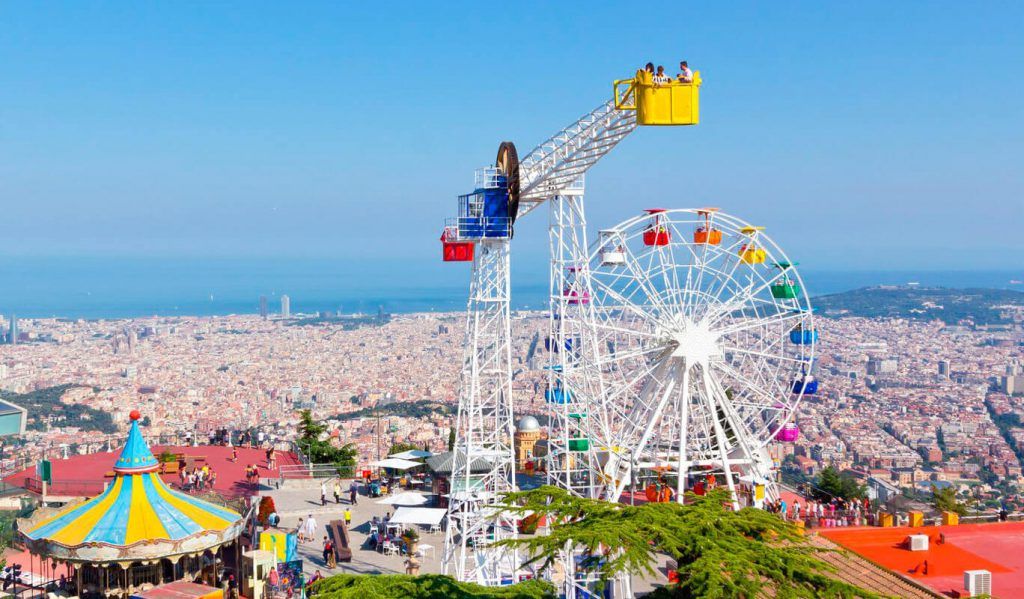
Tibidabo is a mountain about 500 meters above sea level and part of the Collserola range. From the 19th century onward, the hill began to be urbanized. Distinguished buildings and Modernist houses were built there, turning the neighborhood into a residence for Barcelona’s upper class.
There are different ways to reach the summit, from which you can enjoy spectacular views of the city. The most fun way to get there is to take the funicular from the lower part of the hill.
Highlights of Tibidabo
One of the main attractions is Tibidabo Amusement Park. Inaugurated in 1901, it’s the oldest operating amusement park in Spain. It has more than 30 rides and has been chosen for major film shoots, such as a scene in Woody Allen’s Vicky Cristina Barcelona.
The Expiatory Temple of the Sacred Heart is another place worth seeing if you go to the top. This imposing Neo-Gothic construction by architect Enric Sagnier i Villavecchia consists of a lower crypt and a church above.
| PRICE | – Adults: 28,50€. – Under 1.20 m: 10,30€. – Under 90 cm / over 60 years: free entry without access to rides and shows. |
| HOURS | They vary throughout the year. Check the amusement park schedule. |
Encants Market
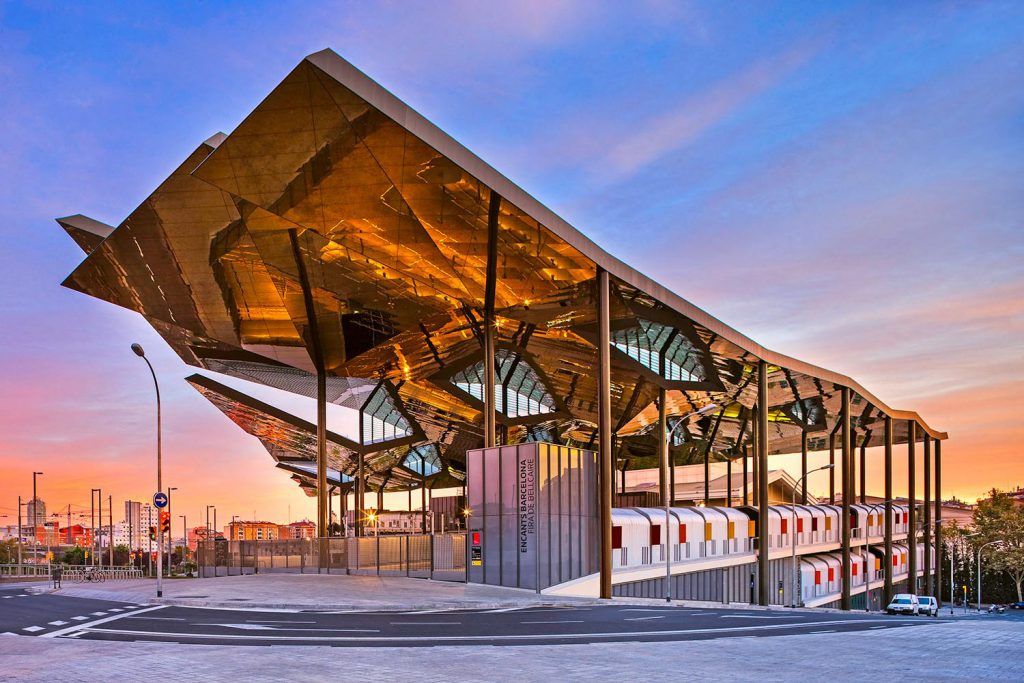
Encants Market is a paradise for collectors, bargain hunters, second-hand goods lovers, and auction enthusiasts. It’s the largest market in the city and at its stalls you can find just about anything you can imagine.
Its origin dates back to the 13th century, making it one of the oldest markets in Europe. Throughout its history it changed location many times. In 2013 it opened its permanent home—an open space protected from sun and rain—designed by the B720 architecture studio.
It’s located in the Eixample district, on what used to be the Bosquet dels Encants, near Glòries, Monumental, or Encants metro stops. It has several floors packed with stalls, accessible by elevators and stairs, and different dining options for visitors.
| PRICE | Free entry. |
| HOURS | Monday, Wednesday, Friday and Saturday from 09:00–20:00. |
La Barceloneta

La Barceloneta is one of the most famous fishing neighborhoods in Spain and is located in the Port Vell district. Until the 18th century it was sparsely populated, but that changed when fishermen began arriving in 1754 thanks to its seaside location. Today, it has a modern touch mixed with the special charm of that era, with very narrow streets and façades weathered by sea salt.
The best thing to do here is wander through its backstreets without worrying about direction and sample its delicious gastronomy. There are also points of interest such as the Museum of the History of Catalonia or the Clock Tower, the latter built in 1772 to serve as the port’s lighthouse. Lastly, there’s Barceloneta Beach—one of the largest, at 578 meters long. It also has extensive sports and leisure facilities for a wonderful afternoon.
How to Get to Barcelona?
Barcelona is one of the most in-demand destinations for travelers from around the world, and one of their main concerns is how to get to the Catalan capital. The main ways to travel to Barcelona are by plane, train, boat, bus, or car.

By Plane
El Prat is the country’s second-busiest airport and is sometimes even cheaper than the train thanks to low-cost airlines (flights for as little as €30). For international flights it’s harder to find such prices, though it’s a matter of searching. To get from the airport to the city center, you have several options:
To reach central Barcelona from the airport, there are several transport options. The Aerobus offers a direct service of about 35 minutes to Plaça Espanya, with intermediate stops. A single ticket costs €5.90 and a return €10.20, valid for 15 days. Children under 4 travel free. Frequency is high: every 5–10 minutes at T1 and every 10–20 minutes at T2. Tickets can be purchased from vending machines or directly on the bus.
As a cheaper alternative—though with a longer journey—there’s the urban bus line 47 (night bus N17) which connects to Plaça Catalunya in approximately one hour. The train service from T2 reaches Passeig de Gràcia in 25 minutes, and for travelers arriving at T1 there’s a free shuttle bus between terminals.
Taxi is another option—the most comfortable but also the most expensive. There are also private transport services that pick you up at the airport at a cost similar to a taxi, with the advantage of choosing the exact destination point in the city.
By Train
Barcelona Sants Station is the second busiest in Spain after Atocha (Madrid). The AVE high-speed train covers Madrid–Barcelona in just 2 hours 30 minutes, and 90 minutes from Zaragoza. Schedules and fares can be checked at Renfe.com. There are also connections with Valencia, though not on high-speed (AVE), so the journey takes longer and is a less attractive option from that destination.
By Boat
The Port of Barcelona is one of the main gateways to the city and a key reference point in the Mediterranean. The main companies offering trips to other maritime destinations are Trasmediterránea and Baleària, with routes from cities such as Marseille, Rome, Valletta, Athens…
By Bus
If you opt for road transport—skipping flying, sailing, or rails—you can travel by bus without any problem. There are many bus companies (ALSA, for example) that take you to Barcelona from almost any origin. Journeys arrive at Barcelona Nord Station, located in the Fort Pienc neighborhood. For a sense of travel times: the journey from Madrid is about 8 hours, and 10 hours from Santander.
If you choose to travel to Barcelona by car, travel times are a bit shorter than by bus, though it’s still slower than the other options—yet it has its advantages.
Map of the Must-See Places in Barcelona
On this map of Barcelona you can locate all the points of interest we’ve described in this article. That way, you can create your own route and include as many monuments and places as you like. If you miss any, don’t worry—it’s always good to have an excuse to return to this beautiful Spanish city.
The list of places to see in Barcelona could be endless, because it’s a city full of monuments, streets, and buildings that would take weeks to visit. That’s why local guides have made a selection of the must-see places in the Catalan capital so you can focus on what’s truly worth seeing.
In short, Barcelona is one of the essential places to visit for its cultural, historical, artistic, and natural wealth. If you’re planning a trip to this beautiful city—one of the most cosmopolitan and avant-garde in Europe—be sure to keep all the places mentioned in mind.
Best Free Tours in Barcelona
All-in-One Highlights Walking Tour! Gothic quarter and Gaudi buildings Discover the Old Town's histor…
Hola 👋🏼 Are you curious about the history and culture of Catalonia? 🐉Do you want to explore…
Dare to Discover the Dark Side of Barcelona? As night falls and shadows creep acro…
The Gaudí tour is the start tour in Barcelona, this is the #1 tour on Google Maps with over 14,000…
This tour will give you the perfect introduction to understanding a city with a history spanning over two millennia. Come…
The #1 tour on Google Maps with over 19,000 five star reviews! Step in…
🚨 Warning: This is not your average walking tour. With me, you’ll get not only the history behind this beautiful…
Frequently Asked Questions about Barcelona
What is the best time to visit Barcelona?
Spring (March to May) and autumn (September to October) are the best times to visit Barcelona. The weather is pleasant and lets you enjoy both the beach and the city. To experience Las Fallas, the best time is March.
How many days do you need to visit Barcelona?
We recommend a minimum of 3 days to see Barcelona’s most important sights. With a 4–5 day stay you can explore the city more calmly and discover less touristy corners.
What are the best areas to stay in Barcelona?
The best areas to stay are Eixample, near Gaudí’s works; the Gothic Quarter, in the historic heart; and Gràcia, a quieter area with a local vibe. El Born is also an excellent option for its central location and cultural atmosphere.
